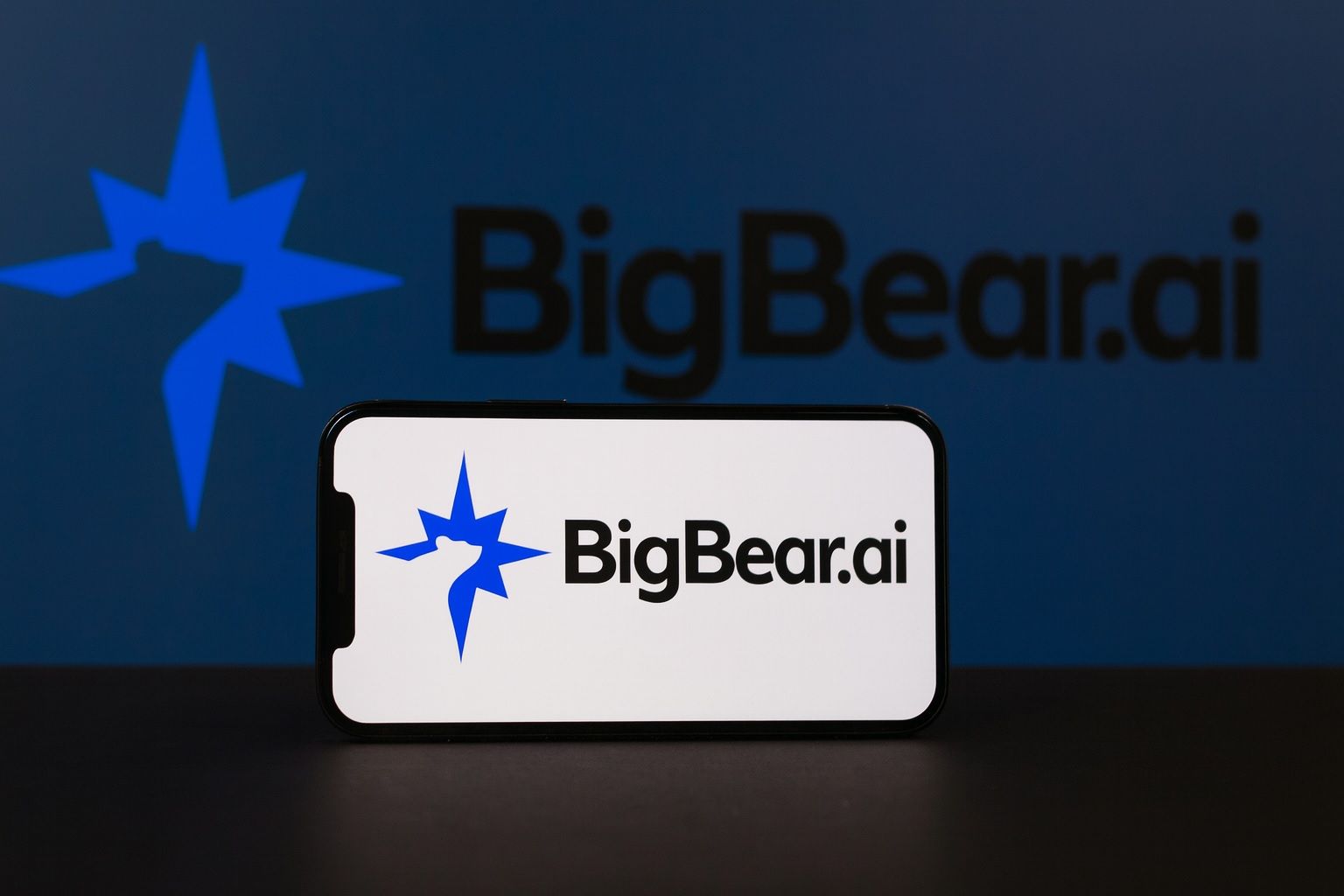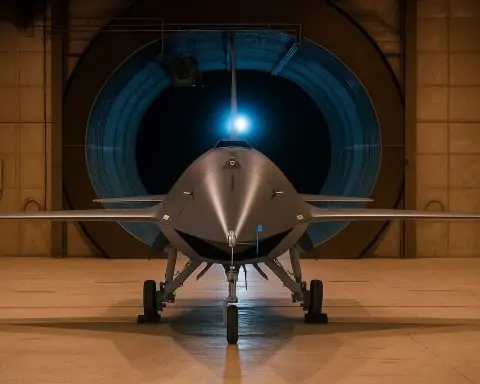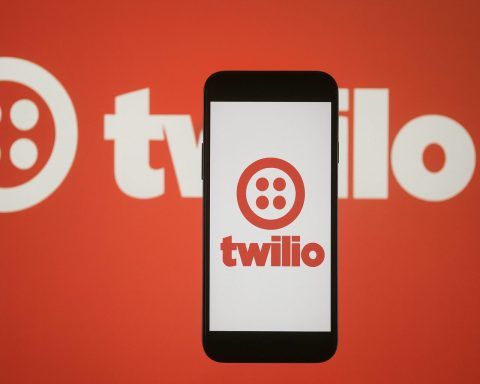- Price: ~$7.24 (closing Oct 10, 2025) [1] (after-hours ~7.71). BigBear.ai’s stock is up roughly 78–82% year-to-date (2025) [2], and about +422% over one year [3].
- Recent News: BigBear.ai partnered with SMX for the U.S. Navy’s UNITAS 2025 exercise [4] and deployed its “veriScan” biometric screening at Nashville Airport [5]. These deals bolster its government/security profile.
- Financials: Q2 2025 revenue was $32.5M (–18% YoY) [6]; GAAP net loss was $228.6M (vs –$14.4M a year ago) [7], due to large one‑time charges. Management cut 2025 sales guidance to ~$125–$140M [8]. As of Q2 it held ~$390M cash and a ~$380M contract backlog [9] [10].
- Analysts: Wall Street is mixed/neutral. Consensus is “Hold” (2 Buys, 2 Holds, 1 Sell) with a 12‑month target around $6.00 [11] (≈–17% from today). Bullish analysts (Cantor, H.C. Wainwright) have Buy ratings with higher targets ($6–$8) citing BigBear’s backlog and rising defense/AI budgets [12] [13].
- Industry: BigBear.ai is often called a “mini-Palantir” for defense analytics [14]. For comparison, Palantir (PLTR) trades near $175 (up ~300% YTD) [15], with ~$1.03B revenue in Q2 [16] (vs BBAI’s $32.5M). Fellow AI firm C3.ai (AI) also competes for government contracts, but has lagged in growth. U.S. government AI/defense funding is surging (a new ~$300B budget dubbed the “One Big Beautiful Bill” [17]).
- Risks/Sentiment: The stock is highly volatile (implied vol ~136%, RSI overbought) [18]. Despite recent highs, BBAI remains ~69% below its 2021–22 peak [19]. Retail sentiment is extremely bullish (trending on StockTwits after Navy news) [20], but quantitative models score it poorly: e.g. Validea’s Small-Cap Growth screen rates BBAI only 45% (profit and growth metrics “Fail”) [21]. Investors should weigh the hype against the company’s weak margins and loss history.
BigBear.ai is a publicly traded AI firm (NYSE: BBAI) based in McLean, Virginia, specializing in “mission-ready AI” solutions for the U.S. government and critical infrastructure [22]. Founded via a 2021 SPAC merger, it leverages machine learning, sensor fusion and advanced analytics to support defense, intelligence, homeland security and customs operations. Its products (e.g. the Arcas™ computer-vision system and ConductorOS edge-AI platform) deliver real-time insights to military and border-security customers. In short, BigBear.ai positions itself as a niche AI analytics vendor – a smaller counterpart to firms like Palantir [23] – with deep ties to defense agencies.
Current Stock Price & Performance
BigBear.ai stock has surged sharply in 2025. After trading below $2 in late 2024, BBAI closed at $7.24 on Oct. 10, 2025 [24]. It had closed about $7.49 on Oct. 9, reflecting a 78–82% YTD gain [25]. (For context, Palantir shares rallied ~300% in 2025 [26].) The rally came in leaps and bounds: for example, news of the Navy UNITAS exercise on Sept 23 lifted BBAI ~11–13% in a day [27]. Conversely, its Q2 earnings miss in August caused a 20–25% one-day drop [28]. Trading has been extremely volatile – intraday swings of 10–14% were common in September [29], and trading volumes spiked on news events. By late Sep the stock’s RSI hit overbought territory [30], and implied volatility is roughly 136% [31], suggesting a likely pullback in the near term if no new catalysts emerge.
Recent News & Strategic Developments
BigBear.ai has announced several high-profile collaborations and contracts in the past few weeks. On Sept 23, 2025 it revealed a partnership with SMX for the U.S. Navy’s UNITAS 2025 exercise [32]. In this multinational maritime drill (Sept 15–Oct 6), BBAI will deploy its AI-powered sensor-fusion and domain-awareness tools on unmanned vehicles to track illicit trafficking and improve fleet situational awareness [33]. CEO Kevin McAleenan noted this “underscores BigBear.ai’s commitment to equipping U.S. and allied forces with mission-ready AI” [34]. Earlier (Sept 11), BigBear.ai began supporting U.S. Customs at Nashville International Airport with its “veriScan” biometric passenger-processing system [35]. The company says this facial-recognition solution lets eligible travelers bypass passport checks, speeding Customs clearance [36].
These recent wins add to a growing pipeline of government work. Notably, BigBear.ai landed a five-year $165.15M U.S. Army contract in late 2024 for the Army’s Global Force Information Management program [37]. The company also cites previous projects in Middle Eastern customs and Panama cargo security. (It even bought naming rights to the NFL’s Washington Commanders’ facility – largely a branding play.) Meanwhile, management trimmed 2025 guidance: it now expects roughly $125–$140M in 2025 revenue (vs $160–$180M before) [38] and has withdrawn profit targets amid execution uncertainty. The consensus view is that BigBear’s recent defense/AI deals (Navy, biometrics, etc.) have offset investor concerns from the Q2 miss [39], bolstering confidence in its long-term positioning.
Financials & Outlook
BigBear.ai’s fundamentals remain challenging. In Q2 2025 the company reported $32.5M in revenue (down 18% YoY) [40], well below expectations. Profitability was worse: GAAP net loss hit –$228.6M [41] (versus –$14.4M a year ago), driven largely by non-cash items (≈$135.8M from a convertible-note revaluation and a $70.6M goodwill write-down) [42]. On an adjusted basis (excl. one-offs), the underlying business still burned cash (Adj. EBITDA roughly –$8.5M) due to low gross margins (~25%) and elevated R&D spend [43]. Thus far there is no clear path to profitability: BigBear’s annual revenues have grown only in the single digits (≈3% CAGR) while expenses are high [44] [45].
That said, the balance sheet is strong. Q2 cash was about $390.8M [46], up sharply from last year. Long-term debt is “modest” and the contract backlog stands at ~$380M [47] – offering some future revenue visibility. These buffers underpin some analysts’ optimism, but the valuation is rich relative to sales (TS2 notes ~13× 2025 revenues) [48]. Looking ahead, the 6–12 month forecast hinges on execution: optimists argue that landing more government contracts (and leveraging the large cash reserves) could push BBAI to the upper end of analyst targets (~$6–$8) [49] [50]. Pessimists counter that without better margins or a scalable product line, the stock could revisit lower levels. Overall, Medium-term expectations are cautious: Wall Street’s average 1-year target is around $6.00 [51] (implying ~20% downside).
Analyst Commentary & Price Targets
Wall Street’s view is split. Cantor Fitzgerald’s Jonathan Ruykhaver (Buy) raised his target to $6 on Sept 2025, citing BigBear’s ~$380M backlog and strategic acquisitions [52]. Similarly, H.C. Wainwright’s Scott Buck (Buy) set a $8 target, noting that BigBear’s Q2 miss was largely timing-related and that the company “could benefit from the new $300B+ ‘One Big Beautiful Bill’ defense/AI budget” [53]. These bulls believe continued defense spending will drive growth. By contrast, MarketBeat reports the consensus (“Hold” from 2 buys, 2 holds, 1 sell) with a $6.00 average target [54]. The high/low targets among analysts are $8.00 and $4.00 [55] (data aggregator AlphaSpread shows a mean 1-year target of only $4.85 [56]). In short, analysts generally assume BBAI will trade in the $5–8 range next year, unless the company beats expectations. Many technical and quantitative indicators, however, suggest caution: TS2’s technical analysis points out that BBAI’s RSI and momentum are already overheated [57].
Industry Trends & Competitors
BigBear.ai operates in a hot defense-AI niche. U.S. defense and intelligence agencies are pouring money into AI and analytics [58]. To illustrate the scale, larger players have exploded: Palantir (PLTR) – BigBear’s closest big-cap peer – trades near $175 (Oct 13, 2025) after rallying ~300% YTD [59]. By contrast, BigBear.ai’s latest quarter was only $32.5M in sales [60]. Palantir’s Q2 revenue (~$1.03B) dwarfed BigBear’s [61]. Fellow analytics firm C3.ai (AI) also serves government customers, but its revenue growth has been more modest and its 2025 stock performance flat. In general, BigBear.ai sells highly customized solutions, so its gross margins (~25–30%) are far below Palantir’s (~80%) [62]. If BigBear is to keep pace, it must scale up rapidly. Its advantage is deep government ties; its risk is that more agile or well-funded competitors (including large defense contractors adding AI) may capture market share.
Risks & Investor Sentiment
Investing in BBAI carries clear risks. Despite recent gains, BBAI remains far below past highs – it traded above $16 in April 2022 and is still ~69% below that peak [63]. The stock has been a rollercoaster: after surging in September, it can drop sharply on bad news (e.g. the Aug earnings miss) [64]. Implied volatility is extremely high (~136%) [65], and technical indicators suggest the rally is over-extended. Retail investors have been very enthusiastic (stock tickers and social media have buzzed about this “AI-defense play” [66]), but fundamental metrics lag. BigBear.ai’s losses are still mounting (it burned through cash in Q2 [67]), and it has a history of equity dilution. Quantitative models reflect these weaknesses: for instance, Validea’s Motley Fool Small-Cap Growth model scores BBAI just 45% (with FAIL grades on profit margin, sales and EPS growth, and cash flow) [68]. In a nutshell, the risk factors include BigBear.ai’s low margins, continued red ink, and dependence on federal funding. Until its revenues stabilize and costs shrink, many analysts believe the stock could retrace if investor enthusiasm fades [69] [70].
In summary, BigBear.ai has become an “AI defense darling” in the market, powered by new Navy and airport contracts [71] [72] and a supportive budget environment. However, its medium-term outlook (6–12 months) is guarded: analysts expect BBAI to consolidate in a roughly $5–7 range unless it delivers stronger growth. Over the longer term (1–3 years), success hinges on scaling the business. If BigBear.ai can translate its backlog and cash reserves into ongoing revenue growth, it could justify a higher valuation. If not, skeptics warn the stock’s run may fizzle. Investors should watch upcoming contract wins and quarterly results closely before betting on continued upside.
Sources: Authoritative press releases and market reports as cited above [73] [74] [75] [76] [77] [78] [79] [80] [81]. (Graphics from BigBear.ai and competitor announcements.)
References
1. www.marketbeat.com, 2. ts2.tech, 3. ts2.tech, 4. ir.bigbear.ai, 5. ts2.tech, 6. ts2.tech, 7. ts2.tech, 8. ts2.tech, 9. ts2.tech, 10. ts2.tech, 11. ts2.tech, 12. ts2.tech, 13. ts2.tech, 14. ts2.tech, 15. ts2.tech, 16. ts2.tech, 17. ts2.tech, 18. ts2.tech, 19. ts2.tech, 20. ts2.tech, 21. ts2.tech, 22. ts2.tech, 23. ts2.tech, 24. www.marketbeat.com, 25. ts2.tech, 26. ts2.tech, 27. ts2.tech, 28. ts2.tech, 29. ts2.tech, 30. ts2.tech, 31. ts2.tech, 32. ir.bigbear.ai, 33. ir.bigbear.ai, 34. ir.bigbear.ai, 35. ts2.tech, 36. ts2.tech, 37. www.businesswire.com, 38. ts2.tech, 39. ts2.tech, 40. ts2.tech, 41. ts2.tech, 42. ts2.tech, 43. ts2.tech, 44. ts2.tech, 45. ts2.tech, 46. ts2.tech, 47. ts2.tech, 48. ts2.tech, 49. ts2.tech, 50. ts2.tech, 51. ts2.tech, 52. ts2.tech, 53. ts2.tech, 54. ts2.tech, 55. ts2.tech, 56. ts2.tech, 57. ts2.tech, 58. ts2.tech, 59. ts2.tech, 60. ts2.tech, 61. ts2.tech, 62. ts2.tech, 63. ts2.tech, 64. ts2.tech, 65. ts2.tech, 66. ts2.tech, 67. ts2.tech, 68. ts2.tech, 69. ts2.tech, 70. ts2.tech, 71. ts2.tech, 72. ts2.tech, 73. ir.bigbear.ai, 74. ir.bigbear.ai, 75. www.businesswire.com, 76. ts2.tech, 77. ts2.tech, 78. ts2.tech, 79. ts2.tech, 80. www.marketbeat.com, 81. ts2.tech









